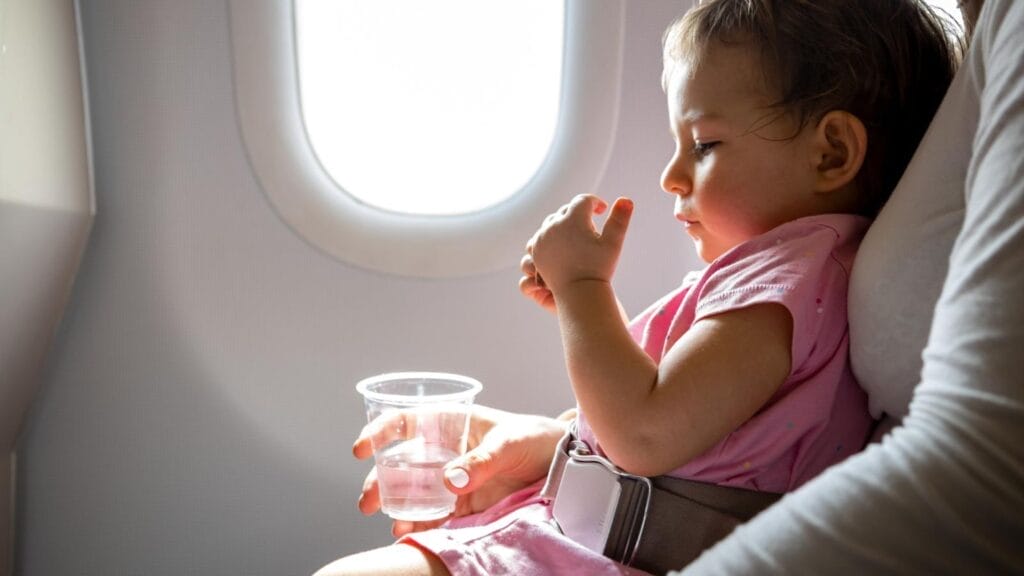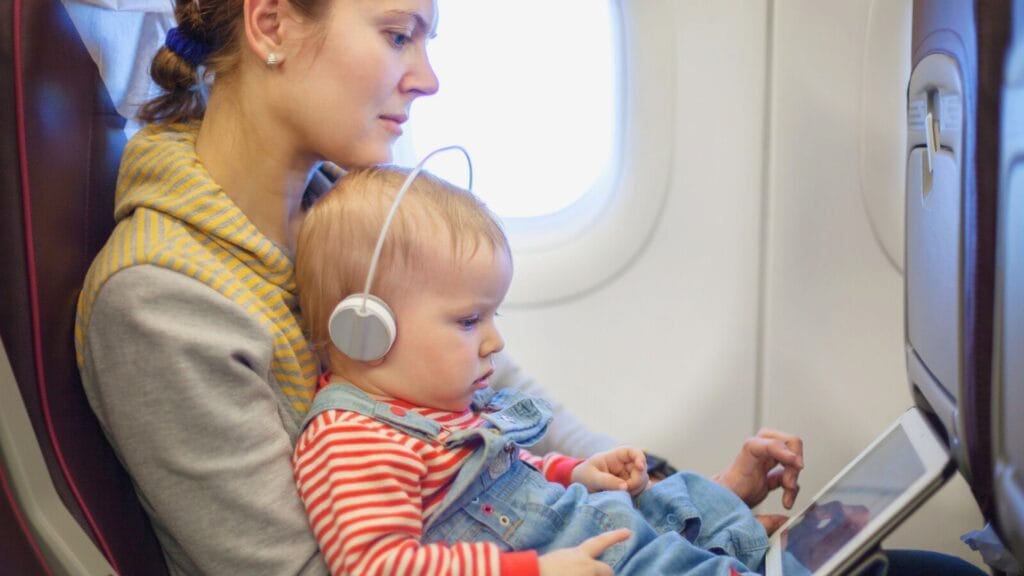Tips for Flying with a Baby: How to Protect Their Ears and Prevent Airplane Ear Pain
Flying with a baby can be an exciting adventure, but it also comes with its fair share of challenges. One of the most common issues parents face during air travel with infants is ear discomfort. Understanding how to protect your baby’s ears and make their flying experience more comfortable is crucial.
In this guide, we’ll explore the importance of safeguarding your baby’s ears during flights and delve into the common ear discomfort problems that infants may experience on airplanes. We’ll discuss signs like fussiness, ear pulling, and the sensation often known as ‘airplane ear.’ By the end of this article, you’ll have a better understanding of how to keep your little one’s ears happy and healthy while flying.
Why Babies Experience Ear Discomfort During Flights
Understanding baby ear pain starts with the role of the eustachian tubes. These tiny passageways connect the middle ear to the back of the throat, helping to equalize ear pressure. In adults, they’re well-developed and open regularly to keep pressure balanced. Babies’ eustachian tubes, however, are shorter, narrower, and more horizontal, which means they don’t work as efficiently. This immature eustachian tube development makes it harder for little ears to adjust when cabin pressure shifts quickly during takeoff and landing.
When a plane ascends or descends, rapid changes in air pressure cause a difference between the outer air pressure and the middle ear. Adults can easily “pop” their ears by swallowing or yawning, but babies often can’t manage this naturally. That’s why you might see your infant fussing, pulling at their ears, or feeling blocked — it’s their body’s way of signaling discomfort caused by trapped air and pressure imbalance inside their ears.
Effective Strategies to Protect Your Baby’s Ears in Airplane
1. Feeding During Takeoff and Landing
Feeding your baby during takeoff and landing can significantly help alleviate ear pressure discomfort. When babies suck and swallow while feeding, it helps equalize the pressure in their ears, reducing the chances of pain or discomfort.
- For breastfeeding moms, nursing your baby during these critical flight phases is ideal.
- If bottle-feeding, offer a bottle to your little one to encourage swallowing and provide relief.
- Using pacifiers is another effective strategy to promote swallowing and ease ear pressure. Encouraging your baby to suck on a pacifier can be soothing and beneficial during these times.
2. Using Ear Protection Devices
When it comes to preparing for a flight with your baby, ear protection devices are essential for traveling with infants. Specialized infant earplugs, like EarPlanes, are designed to regulate pressure changes by slowing the rate at which air enters and leaves the ear canal. This helps reduce that uncomfortable “pop” feeling and often prevents fussiness related to ear pain during takeoff and landing.
Noise reduction is another factor parents consider. Infant earmuffs don’t just block loud airplane noises; they create a calming environment, helping your little one stay relaxed during the flight. Look for earmuffs specifically made for babies and toddlers — lightweight, soft, and adjustable models that won’t irritate fragile skin.
Here are some trusted product ideas:
- Baby Banz Earmuffs – Top-rated for noise reduction and comfort.
- Alpine Muffy Baby Earmuffs – Great balance of sound protection and fit.
These tools work hand-in-hand with timing feedings plane-side or breastfeeding takeoff landing techniques to offer comprehensive bottle-feeding airplane ear relief and comfort. If you’ve ever wondered, how do I protect my baby’s ears on a plane?, combining these devices with smart feeding strategies covers it well.
3. Timing and Preparation for the Flight
Proper timing and preparation can make a significant difference in your baby’s comfort during the flight. Here are some tips to help you:
Plan Feeding Schedules

- Try to plan your feeding schedule so that it aligns with the takeoff and landing times of your flight. This can help ease any discomfort your baby may feel due to changes in pressure during these critical moments.
- If you’re breastfeeding, remember that it’s perfectly fine to breastfeed during takeoff and landing. The sucking motion can help your baby equalize their ear pressure.
Practice Sucking Techniques
- Before your trip, practice different sucking techniques with your baby. This can include using a pacifier or bottle, if applicable. Familiarizing them with these methods beforehand can make in-flight feeding or pacifier use smoother.
Pack Essential Items
- Make sure to pack essential items that will keep your baby calm and hydrated throughout the flight. This includes snacks, drinks, and toys.
- Having these items readily available can help distract your baby during the flight and keep them comfortable.
By planning ahead and being prepared, you can ensure a more enjoyable flying experience for both you and your baby.
4. Keeping Baby Awake During Critical Moments
Encouraging Swallowing Reflexes
Encouraging the baby to stay awake during critical moments such as takeoff and landing can aid in promoting swallowing reflexes. This action helps equalize the pressure in their ears, reducing the chances of discomfort or pain.
Gentle Tips for Alertness
To keep your baby alert without causing stress or overtiredness, consider gentle methods such as engaging them with soothing sounds or gentle movements. Additionally, interacting with your baby through eye contact and soft conversation can help maintain their wakefulness without overwhelming them.
Feeding Tips During Travel
In certain situations, what you feed your baby while traveling can also play a significant role in keeping them awake. Offering a small snack or drink during these crucial phases of the flight can encourage swallowing and help with ear pressure adjustments. Just ensure the food is suitable for travel and easy for your baby to consume.
By ensuring your baby stays awake during these crucial phases of the flight and providing appropriate nourishment, you can actively support their ear health and comfort throughout the journey.
5. Maintaining Hydration Throughout the Flight
Keeping your baby well-hydrated during a flight is essential for their overall comfort and can help reduce ear pressure issues. Here are some strategies to ensure your little one stays hydrated while traveling:
- Timing Feedings: Plan your feeding schedule in advance, especially during takeoff and landing when ear pressure changes occur. Breastfeeding or bottle-feeding during these times can provide relief to your baby’s ears.
- Offer Fluids: If your baby is old enough to drink from a cup or straw, offer them fluids such as water or diluted juice throughout the flight. This will help keep them hydrated and also encourage swallowing, which can alleviate ear discomfort.
- Use Sippy Cups or Spill-Proof Containers: To avoid spills and messes on the plane, use sippy cups or spill-proof containers for your baby’s drinks. This will make it easier for them to drink independently and reduce the chances of liquid getting everywhere.
- Pack Extra Snacks: In addition to fluids, pack extra snacks that are easy for your baby to eat on the go. Healthy snacks like fruits, yogurt pouches, or granola bars can be great options to keep them satisfied and hydrated during the flight.
6. Consulting a Pediatrician Before Flying
Before flying with your baby, it’s important to consult a pediatrician, especially if your little one is unwell. Here’s when you should seek medical advice and what precautions to take:
Comforting Your Baby During the Flight

Strategies for Staying Calm
- Stay composed to avoid transferring anxiety to your baby.
- Use a soothing voice and gentle touch to comfort them.
- Distract with toys or songs to shift focus from discomfort.
Reassuring Your Infant
- Maintain eye contact to establish a sense of security.
- Offer a favorite blanket or cuddly toy for comfort.
- Rock or sway gently to provide a calming motion.
Familiar Routines and Comforting Items
- Stick to regular feeding or nap schedules if possible.
- Bring along familiar snacks or drinks that your baby enjoys.
- Use a baby carrier or sling for closeness and reassurance.
Remember, your calm demeanor and familiar comforts can go a long way in easing your baby’s distress during the flight.
Post-Flight Care and Monitoring Your Baby’s Ears
Keeping an eye on your little one’s ears after the flight is just as important as protecting them during. Babies can sometimes experience lingering discomfort or even develop complications like ear infections following air travel. Here are key signs to watch for in your post-flight baby ear care routine:
- Persistent fussiness or crying, especially when touching or rubbing the ears
- Pulling at the ears more than usual, which might indicate ongoing pain
- Difficulty sleeping due to ear discomfort
- Fever or unusual irritability that could signal infection
- Fluid drainage from the ear, a sign that needs prompt attention
If any of these symptoms last beyond 24–48 hours after landing, it’s wise to reach out to your pediatrician. Early medical advice can prevent minor pressure issues from turning into something more serious, ensuring your baby stays comfortable and happy after the trip. Regularly checking in with healthcare providers helps keep those tiny ears in tip-top shape during your travel adventures.
Additional Travel Hacks for Stress-Free Family Flights
Using Supportive Carriers
Opt for baby carriers that allow easy access for breastfeeding on the go, ensuring both comfort and convenience during flights. Look for carriers with adjustable straps and proper head support for your little one.
Efficient Packing Strategies
Pack a comfort kit with essential items like extra pacifiers, favorite toys, and a cozy blanket to soothe your baby during the flight. Consider noise-canceling headphones for babies to minimize sound disturbances and create a peaceful environment.
By implementing these family travel hacks, you can enhance your flying experience with your baby, making it more enjoyable and stress-free. If you’re considering a trip to Europe, check out these 5 best toddler-friendly destinations which could make your family travel even more memorable.
Conclusion
With these expert tips, you can prepare ahead for a smoother travel experience with your little one. Remember, with these easy hacks, flying with infants can be stress-free. Protect your baby’s ears on the plane and enjoy a worry-free journey!


